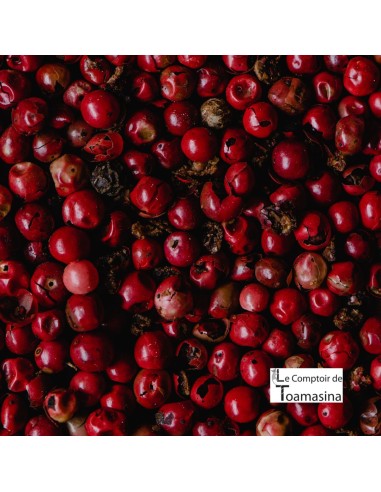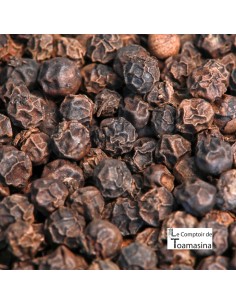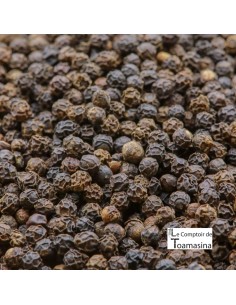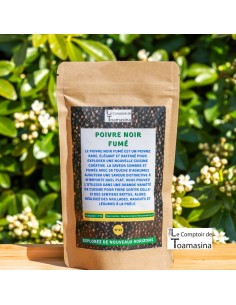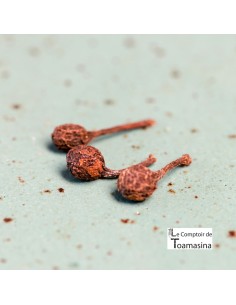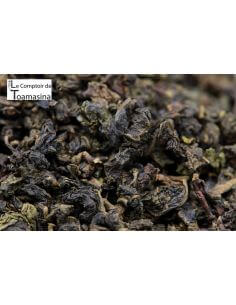The “pink pepper” fruit comes from the aroeira tree, native to South America and part of the same family as the mango or cashew nut. Although pink pepper has a slight peppery note, it differs from both red and black pepper.
There are two main species producing pink berry: pepper mastic (Schinus terebintifolius, native to Brazil) and salsa mastic (Schinus Molle, native to cooler regions of South America). These two varieties are similar and produce edible berries.
The cultivation of pink berries is mainly concentrated in Brazil, with the Schinus terebinthifolius species predominating. Here are some details about their culture in this country:
Initially developed in Brazil, the culture gradually spread to other regions such as the United States, New Caledonia, Reunion and Madagascar. Today, Brazil and Madagascar remain the main world producers of pink berries from this species.
The state of Bahia, Brazil, is renowned for its significant production of pink berries, characterized by exceptional quality. The berries are sorted by hand and dried in a natural way, ensuring a high quality product.
Although the species is native to the Andes in Peru, it is primarily used on the Brazilian coast for its bright pink seeds.
Brazilian pink berries are distinguished by their magnificent color ranging from pale pink to carmine red. Their exceptional taste is sweet, resinous and floral, devoid of bitterness or spiciness.
Description of the Tree
The aroeira-vermelha, an evergreen species, begins its growth reaching between 5 and 10 meters in height and a trunk of 20 to 30 cm in diameter. When mature, this tree can reach up to 15 meters in height with a trunk diameter of up to 60 cm.
The trunk of the aroeira-vermelha is generally twisted and short, with a broad, rounded, relatively sparse crown. Main branches develop directly from the trunk, giving rise to secondary branches that grow horizontally at different angles, illustrating the botanical phenomenon of plagiotropism. Unlike other trees, the aroeira-vermelha does not develop vertical (orthotropic) branches.
Its outer bark is dark, thick, rough and ridged, breaking off in irregular patches. The inner bark is reddish, fibrous and gives off a characteristic turpentine odor.
The leaves, compound and imparipinnate, are glabrous and alternate, composed of 9 to 11 leaflets. The young leaves have a trifoliate structure, and the rachis is finely winged between each pair of leaflets. The leaflets are oblong to lanceolate, green and have serrated or smooth edges.
The flowers, present on male and female trees, are actinomorphic, pentamerous and dicline. They consist of five green sepals, five white petals and a golden nectar disc. Male flowers contain ten stamens with yellow dorsifixed anthers, while female flowers have a trilobed stigma, a superior unilocular ovary with a single ovule, and a nonfunctional androecium.
The fruit is a round drupe 4 to 5.5 mm in diameter, changing from light green to red when ripe. This fruit, with a sweet and aromatic taste, is used as a condiment under the name pink pepper. It contains only one kidney-shaped seed with a smooth, light yellow shell marked with a dark brown spot.
Seeds and Reproduction
The seeds of the aroeira-vermelha are of the orthodox type, and their conservation depends on environmental conditions: they can be stored up to 360 days with 7.8% humidity in a dry room, up to six months with 12. 6% humidity in a cold room, and up to five months in the laboratory with 12.6% humidity. A kilogram of dry seeds contains approximately 35,000 units, with each thousand seeds weighing approximately 24.5 g. The seeds are mainly dispersed by birds of various families.
The aroeira-vermelha is a dioecious species, requiring cross-pollination by insects such as bees, flies and wasps. Flowering and fruiting are influenced by increasing temperature, water availability and day length.
On the Santa Catarina coast, flowering occurs in two periods: from October to November and from February to April. In Curitiba, flowering begins in February, with the first fruits visible 29 days later and reaching maturity between April and May. In the Northern Fluminense restingas, flowering is most intense during the summer, with fruiting taking place between April and July.
In Sooretama, ES, two periods of flowering and fruiting are observed: from mid-November to January and from May to June, with peak production between late May and early June.
Natural Distribution
Aroeira-vermelha is found naturally in eastern and northeastern Argentina, eastern Paraguay, Uruguay, and several Brazilian states. Introduced to Florida in 1898, it became an invasive species and also spread to Europe and South America.
Operation
Aroeira-vermelha is widely harvested by farmers and local communities, particularly in areas where the fruit processing industry is present. The sale of fruit provides additional income to local populations, especially women and young people.
However, this exploitation is often not sustainable. Sometimes trees are felled to facilitate harvesting, especially on private land intended to be converted to crops or pastures in the short term. Managers who practice sustainable harvesting methods do not receive additional recognition or benefits.
Some industries seek to raise awareness among producers by providing equipment to improve the quality of the harvest. To ensure sustainable production, the development of cultivation techniques for aroeira-vermelha is essential.
Climate and Soil
The aroeira-vermelha adapts to a variety of climates, from arid regions with annual rainfall of 700 mm to humid areas with rainfall of 1,300 mm. It prefers well-drained, acidic or slightly acidic soils with an aluminum saturation of less than 50%.











